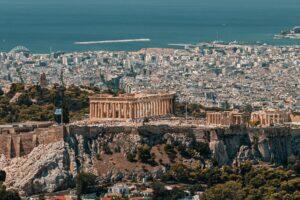Fodor's Expert Review National Archaeological Museum
Many of the greatest achievements in ancient Greek sculpture and painting are housed here in the most important museum in Greece. Artistic highlights from every period of its ancient civilization, from Neolithic to Roman times, make this a treasure trove beyond compare. With a massive renovation completed, works (more than 11,000 of them) that have languished in storage for decades are now on view, reorganized displays are accompanied by enriched English-language information, and the panoply of ancient Greek art appears more spectacular than ever.
While the classic culture that was the grandeur of the Greek world no longer exists—it died, for civilizations are mortal—it left indelible markers in all domains, most particularly in art, and many of its masterpieces are on show here. The museum's most celebrated display is the Mycenaean Antiquities. Here are the stunning gold treasures from Heinrich Schliemann's 1876 excavations of Mycenae's royal tombs: the... READ MORE
Many of the greatest achievements in ancient Greek sculpture and painting are housed here in the most important museum in Greece. Artistic highlights from every period of its ancient civilization, from Neolithic to Roman times, make this a treasure trove beyond compare. With a massive renovation completed, works (more than 11,000 of them) that have languished in storage for decades are now on view, reorganized displays are accompanied by enriched English-language information, and the panoply of ancient Greek art appears more spectacular than ever.
While the classic culture that was the grandeur of the Greek world no longer exists—it died, for civilizations are mortal—it left indelible markers in all domains, most particularly in art, and many of its masterpieces are on show here. The museum's most celebrated display is the Mycenaean Antiquities. Here are the stunning gold treasures from Heinrich Schliemann's 1876 excavations of Mycenae's royal tombs: the funeral mask of a bearded king, once thought to be the image of Agamemnon but now believed to be much older, from about the 15th century BC; a splendid silver bull's-head libation cup; and the 15th-century BC Vapheio Goblets, masterworks in embossed gold. Mycenaeans were famed for their carving in miniature, and an exquisite example is the ivory statuette of two curvaceous mother goddesses, each with a child nestled on her lap.
Withheld from the public since they were damaged in the 1999 earthquakes, but not to be missed, are the beautifully restored frescoes from Santorini, delightful murals depicting daily life in Minoan Santorini. Along with the treasures from Mycenae, these wall paintings are part of the museum's Prehistoric Collection.
Other stars of the museum include the works of Geometric and Archaic art (10th to 6th century BC), and kouroi and funerary stelae (8th to 5th century BC), among them the stelae of the warrior Aristion signed by Aristokles, and the unusual Running Hoplite (a hoplite was a Greek infantry soldier). The collection of Classical art (5th to 3rd century BC) contains some of the most renowned surviving ancient statues: the bareback Jockey of Artemision, a 2nd-century BC Hellenistic bronze salvaged from the sea; from the same excavation, the bronze Artemision Poseidon (some say Zeus), poised and ready to fling a trident (or thunderbolt?); and the Varvakios Athena, a half-size marble version of the gigantic gold-and-ivory cult statue that Pheidias erected in the Parthenon.
Light refreshments are served in a lower ground-floor café, which opens out to a patio and sculpture garden. Don't forget to also check the museum's temporary exhibitions.
READ LESS







